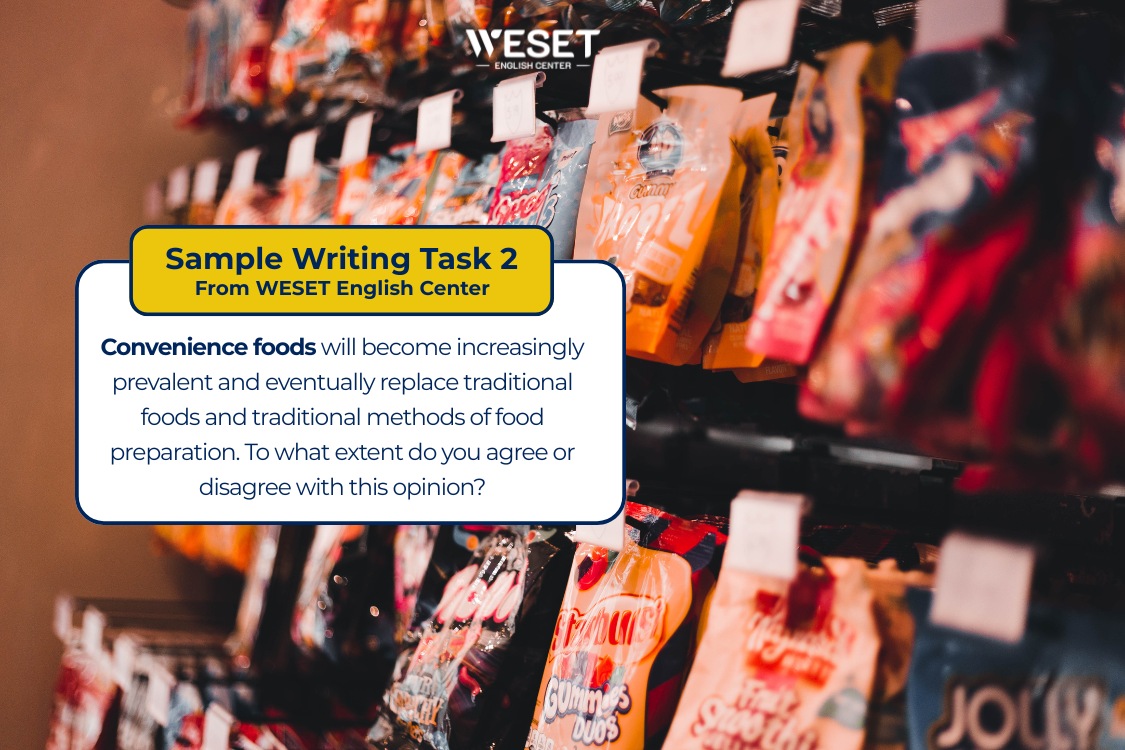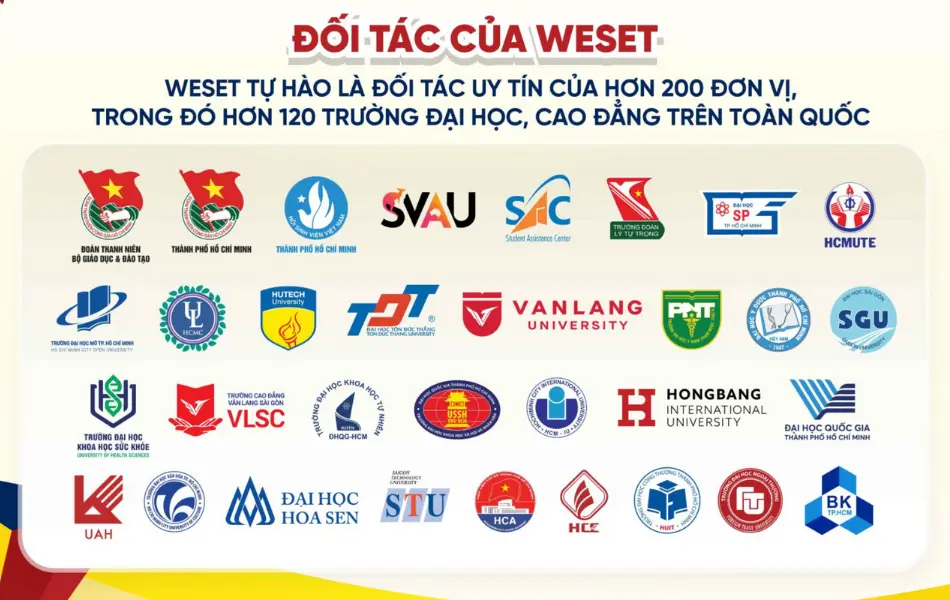Trang chủ Blog Bài thi IELTS mẫu Bài mẫu Task 2 IELTS Writing sample Sample IELTS Writing Task 2: Convenience foods
Sample IELTS Writing Task 2: Convenience foods
- Admin
- Bài mẫu Task 2 IELTS Writing sample
MỤC LỤC
IELTS Writing Task 2 Opinion Essay là gì?
Đặc điểm nhận diện
Opinion Essay (hay Agree or Disagree Essay) là dạng đề yêu cầu đưa ra quan điểm cá nhân. Các câu hỏi thường có cụm từ như “To what extent do you agree or disagree?”, “Do you agree or disagree?” hoặc “What is your opinion?”.
Nhiệm vụ của thí sinh
Thí sinh cần nêu quan điểm rõ ràng — có thể hoàn toàn đồng ý, hoàn toàn phản đối, hoặc đồng ý một phần — rồi phát triển luận điểm bằng lý do, ví dụ hoặc dẫn chứng.
Cấu trúc bài viết gợi ý
- Introduction: Paraphrase đề và nêu quan điểm.
- Body paragraph 1: Lập luận chính ủng hộ quan điểm.
- Body paragraph 2: Lập luận bổ sung hoặc phản bác (tùy quan điểm).
- Conclusion: Tóm tắt và khẳng định lại quan điểm.
Ví dụ đề
“Convenience foods will become increasingly prevalent and eventually replace traditional foods and traditional methods of food preparation. To what extent do you agree or disagree?”
Kết luận ngắn
Opinion Essay yêu cầu bạn thể hiện và bảo vệ quan điểm cá nhân thông qua lập luận logic và ví dụ minh họa.
Bài mẫu IELTS Writing Task 2: Convenience foods
Đề bài: Convenience foods will become increasingly prevalent and eventually replace traditional foods and traditional methods of food preparation. To what extent do you agree or disagree with this opinion?
Dàn bài
Introduction: Paraphrase lại đề bài và nêu rõ quan điểm cá nhân: Thức ăn tiện lợi ngày càng phổ biến và có thể thay thế hoàn toàn thức ăn truyền thống và cách nấu ăn truyền thống → Bài viết phản đối một phần quan điểm này – tức là không đồng tình hoàn toàn, vì mặc dù thức ăn nhanh sẽ phát triển, nhưng không thể thay thế hoàn toàn ẩm thực truyền thống
Body
Đoạn 1: Những lợi ích khiến thực phẩm tiện lợi ngày càng phổ biến
- Tiết kiệm thời gian, đặc biệt phù hợp với lối sống bận rộn hiện nay → Dễ bảo quản, dễ vận chuyển và có mặt ở khắp nơi
- Công nghệ chế biến ngày càng tiên tiến giúp thực phẩm tiện lợi ngon miệng hơn và an toàn hơn trước
Đoạn 2: Tại sao thực phẩm tiện lợi không thể thay thế hoàn toàn ẩm thực truyền thống
- Ẩm thực truyền thống gắn liền với văn hóa, bản sắc dân tộc và gia đình – không thể thay thế bằng sản phẩm công nghiệp → Nấu ăn tại nhà giúp kết nối con người, đặc biệt là trong các dịp lễ, Tết hoặc sự kiện gia đình
- Thực phẩm chế biến sẵn thường kém lành mạnh và thiếu giá trị dinh dưỡng so với thực phẩm tươi nấu tại nhà
Kết bài: Dù thức ăn tiện lợi chắc chắn sẽ phát triển, nhưng không thể hoàn toàn thay thế được món ăn và phương pháp nấu ăn truyền thống
Bài mẫu
Convenience foods have been increasingly popular in recent years, prompting some to assume that they would someday replace conventional meals and preparation techniques. Although I acknowledge that these contemporary food alternatives will proliferate, I vehemently disagree that they will entirely supplant traditional cooking methods and cuisine.
Convenience meals are becoming more and more popular for a number of reasons. First and foremost, they save time and effort, which is especially appealing to those with hectic lifestyles. Traditional meals might take hours to prepare, while packaged or pre-cooked items can be ready in minutes. Second, they are portable and simple to store, so you may find them at workplaces, supermarkets, and even at vending machines. Lastly, as food technology has advanced, convenience meals have improved in taste and appearance while still adhering to safety and hygienic regulations.
But traditional cooking and food still have a lot of value and can not be completely replaced. Traditional meals are closely linked to culture, family customs, and national identity; they are not merely for consumption. For instance, many families still get together to cook and dine around holidays or festivals, and these get-togethers help fortify relationships. Additionally, cooking at home gives you control over the nutrients and components, which manufactured meals sometimes lack. Despite their convenience, many prepared meals are detrimental to long-term health because they are heavy in sugar, salt, and bad fats.
In conclusion, while convenience meals will continue to gain appeal as a result of contemporary lives, they are unlikely to completely replace traditional cuisines and cooking processes since culture, health, and personal connection are still important reasons to maintain traditional food habits.
Từ vựng của bài
| Word | Part of Speech | Vietnamese Meaning |
|---|---|---|
| Prompt | verb (v) | Gây ra |
| Conventional | adjective (adj) | Truyền thống |
| Alternative | noun (n) | Sự thay thế |
| Proliferate | verb (v) | Tăng trưởng |
| Vehemently | adverb (adv) | Một cách kịch liệt |
| Supplant | verb (v) | Thay thế |
| Hectic | adjective (adj) | Bận rộn |
| Adhere | verb (v) | Theo sát |
| Merely | adverb (adv) | Hoàn toàn |
| Fortify | verb (v) | Làm vững chắc |
| Detrimental | adjective (adj) | Có hại |
| Appeal | noun (n) | Sự lôi cuốn |







